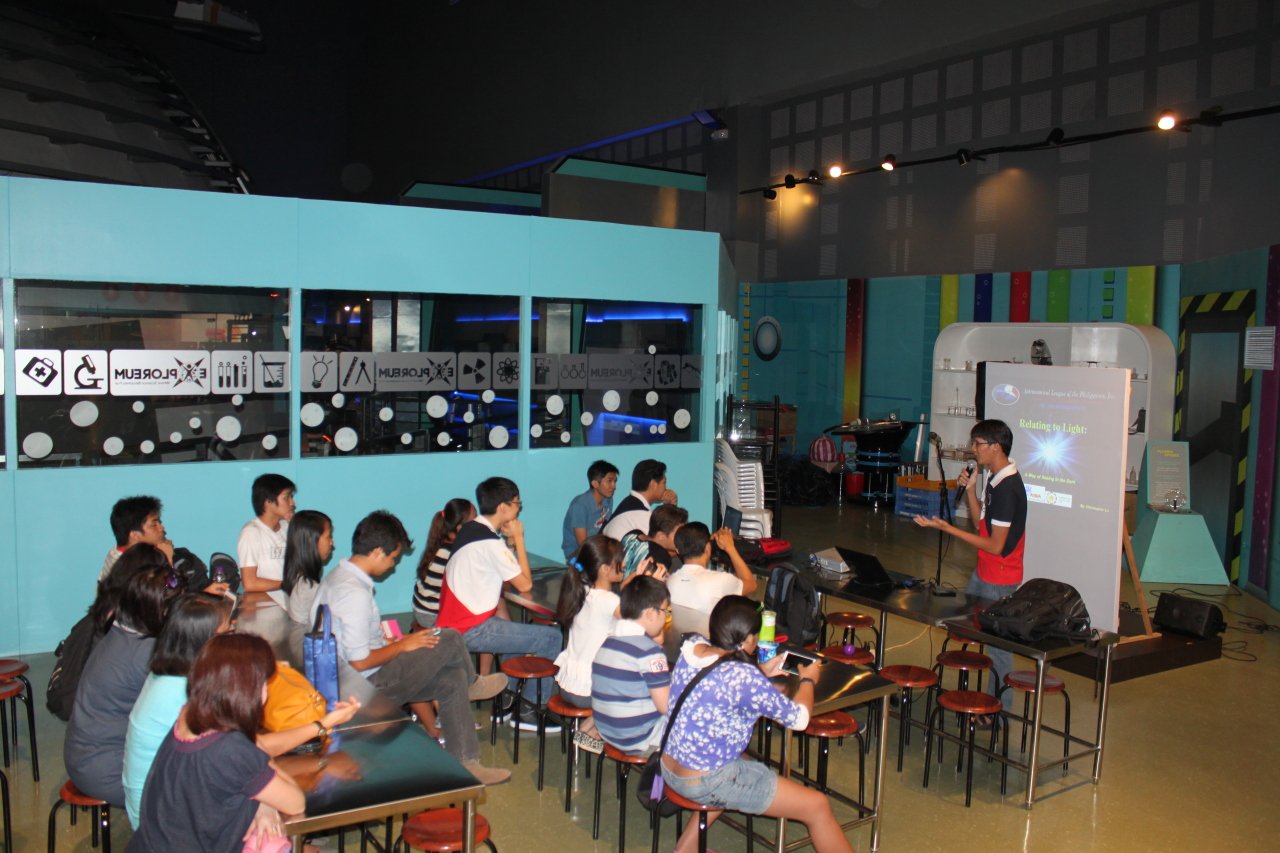May 17, 2015 ALP Monthly
Meeting Report
by James
Kevin Ty
Last May 17, ALP held
their monthly meeting at Exploreum at SM Mall of Asia in
Pasay City. Members who attended were ALP President
James Kevin Ty, wife Charito and son Kendrick Cole KC
Ty; Treasurer Andrew Ian Chan and Iah Serna; Secretary
Christopher Louie Lu , wife Karren and daughter Frances;
director Edge Lat, Peter Benedict Tubalinal ; Justine
Garcia and Norman Marigza. Guests from UP Astro Soc and
RTU Astro Soc members Orville Pelicano, Poly Magaday,
Alfred Soriano, Precious Jara Prestosa , Mark Lenczner
Mendoza, and Mic Caldo.
Meeting started at around 3:00pm
with ALP Secretary Christopher Louie Lu discussion on
Spectroscopy. As
astronomers, we always look at stars. And there are a
variety of stars in the night sky, a mix of different
brightness, color & size. But more that these obvious
traits, it is also through starlight that we know so
much about these beautiful "diamonds in the sky."
Unlocking the secret of starlight takes a collection of
people with the extraordinary knowhow in various fields
of sciences. It was Isaac Newton who first discovered
that white light is composed of different colored light
& he called it the 'Spectra'. This was followed by
Joseph von Fraunhofer who discover that there are dark
lines across the spectra & that these lines are
different and distinct from other stars. These dark
lines will later be called the "Franhofer Absorption
Lines." The partnership of Gustav Kirchoff & Robert
Bunsen who discovered the connection between these
Absorption Lines with the known chemical elements. Both
scientists has successfully figured out how to read
these absorption lines and actually know the star's
chemical composition. Fr. Angelo Secchi, Jesuit Priest &
Astronomer, who made the first classification of stars
based on their color spectra. Henry Drapper who first
took photographs of various spectra from different
stars. Edward Pickering, who took large number of
spectra from a wide field telescope and have each
stellar spectra analyzed & cataloged. Employing a staff
of women to deal with this monumental task as women was
believed to be more patient & thorough in doing them.
There are a few women scientists worth noting. Annie
Jump Canon, who took Fr. Secchi's spectral
classification and improved on it. This method of
stellar classification is now being used by astronomers
since. Henrietta Swan Leavitt, discovered the relation
between the luminosity and the period of Cepheid
variable stars. This period/luminosity relationship will
be used decades on to measure the expansion of the
universe. Cecilia Payne was able to figure out the
color/temperature & hydrogen feul relationship inside a
star. Combining this with the classification system by
Annie Jump Canon, they were able to tell & estimate the
hydrogen feul contents of stars. Data, research and
analysis made by these unsung heroines of astronomical
science was then gathered and compiled by Ejnar
Hurtzprung & Henry Noris Russel to create a diagram that
shows the Brightness/Temperature & Size/Color
relationship of different stars. This diagram is now
known as the "Hurtzsprung-Russel Diagram" & has since
became a powerful tool to astronomers to classify
different types of stars.
This
understanding of the visual spectrum has opened the way
for astronomers to understand the greater parts of the
invisible spectrum, Gamma, X-ray, Ultraviolet, Infrared,
Microwave & Radio wave. Virtually invisible to human
eyes, ingenuity & innovation has enabled us to see these
various parts of the spectrum. We were able to design,
build & send various probes up in our upper atmosphere
to continually see the invisible that led to the
creation of the Chandra X-ray Probe, the Hubble Space
Telescope, the Spintzer & Hechel Infrared Telescopes and
the WMAP Microwave Telescope.
Looking
forward to the next generation of telescopes is the
James Webb Space Telescope which is the successor to the
Hubble Space Telescope. This telescope will be bigger
and could see farther than its predecessor. It could see
well into the visible range but also could see most of
the infrared wave spectrum. Expectations for this
telescope is very high so all preparations & planning is
made very meticulously for it's success. Though this
mission is plagued with delays and budget cuts,
scientist, designers & engineers push on to make it on
its planned launch date on October 2018.
This was
followed by another interesting topic on Measuring
Light: Basics of Photometry by ALPer Norman Marigza.
Photometry is the science of measuring light. It is a
combination of metrology and optics. Light exists in
various forms but photometry's main concern is the
measurement of the flux at visual wavelengths. The flux
received, combined with measurements from spectroscopy
and astrometry will allow us to deduce various
properties of the source.
A demo on how to do photometry was presented using the
software Iris. Differential photometry (measurements
taken at the same image field) was used with the
secondary standard star nu Andromedae and compared
against other stars in the field through the magnitude
equation m1 - m2 = -2.5 log (b1/b2).
Applications on photometry were also described such as:
light pollution studies; transit and eclipse events,
such as those associated with exoplanets and variable
star systems; and limb darkening coefficients to test
against stellar atmosphere models. An astronomy program
was also introduced entitled "Philippine Light Map" in
which the local astronomy community is invited to take
part by providing image data to monitor and determine
local light pollution levels.
Lastly, ALPer Iah Serna and
President James Kevin Ty then invited members to join
ALP's May 31, 2015 Excursion at Canyon Cove in Batangas.
Meeting ended at around 5pm.

Meeting proper started
at 3:00pm |

ALPers and guests
listen to the interesting lecture topics
presented by ALPers Christopher Louie Lu and
Norman Marigza. |

ALP Secretary
Christopher Louie Lu lectures on
Spectroscopy. |

ALPer Norman Marigza
lectures on Measuring Light: Basics of
Photometry. |
|